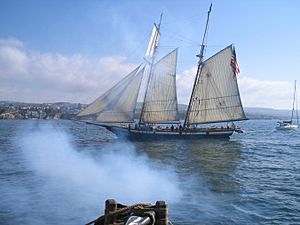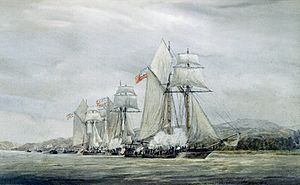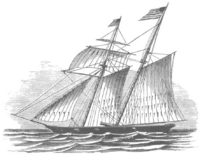Battle of Rappahannock River facts for kids
Quick facts for kids Battle of Rappahannock River |
|||||||
|---|---|---|---|---|---|---|---|
| Part of the War of 1812 | |||||||
 The reconstructed Lynx off California being saluted by Lady Washington. |
|||||||
|
|||||||
| Belligerents | |||||||
| Commanders and leaders | |||||||
| Strength | |||||||
| 4 schooners Marines and Sailors |
17 armed boats Marines and Sailors |
||||||
| Casualties and losses | |||||||
| 6 killed 10 wounded ~100 captured 4 schooners captured |
2 killed 11 wounded 2 armed boats sunk |
||||||
The Battle of Rappahannock River happened in 1813 during the War of 1812. A British navy group was blocking the Rappahannock River in Virginia. They sent many men in boats to attack four American privateers. Privateers were private ships allowed to attack enemy ships. The British won the battle and captured all the American ships.
Contents
Why the Battle Happened
On April 1, 1813, a group of British warships was blocking the Rappahannock River. This group included large ships like the San Domingo and Marlborough. There were also four frigates, two brigs, and one schooner. They were trying to capture American ships.
The British commanders planned a special attack. They would use small boats to capture larger ships that were anchored. This kind of attack was called a "cutting out" expedition.
The next day, the British sent seventeen small boats. These boats carried small cannons called carronades. Each boat had up to fifty marines or sailors. Most of them carried swords. Lieutenant James Polkinghorne was in charge of this group.
Around 4:00 pm, they saw five American ships. The British boats chased them all night. But rowing up the Rappahannock River was hard. Twelve of the British boats fell behind. Only five boats, with 105 officers and men, were left to attack.
The American ships were four armed schooners. They were led by Captain William S. Stafford on the Dolphin. The other schooners were Lynx, Racer, and Arab. In total, the American schooners had 30 cannons and 160 men. Most of these ships were built in Baltimore.
Captain Stafford had to choose between sinking his own ships or fighting. He decided to fight. He lined up his ships with their cannons facing the river's mouth. This was where the British would come from.
The Fight Begins
The largest American ship was Arab. It had over 380 tons but only 45 men. It was at the back of the line. The Dolphin was 300 tons and was Captain Stafford's main ship. It carried 98 men.
When the British boats saw the American ships, they stopped. They waited for the wind to pick up and for the other twelve boats to arrive. Lieutenant Polkinghorne used this time to encourage his men.
But the wind stayed calm. Polkinghorne decided to attack right away. He didn't want to give the Americans more time to get ready or escape. He sent one boat forward with a 12-pounder cannon. It was supposed to start a cannon fight and delay the Americans. But this didn't work. All of Stafford's ships fired their cannons at once.
Lieutenant Polkinghorne then led his boats directly towards the middle two American ships. These were Racer and Lynx. Each was 280 tons and had about 76 men combined. As the British got closer, the Americans fired another round of cannons. Polkinghorne changed course and headed for Arab.
When the British boats got very close, only three were left. Two had been hit and sunk by American fire.
Boarding the Ships
The remaining British sailors boarded the American ships. They shouted as they climbed aboard. The Arab tried to turn to use its other cannons. But the British boarded it before it could. Its commander then ran the ship aground on the riverbank.
Racer and Lynx were quickly captured. Their crews gave up as the British climbed onto their decks. Some American sailors jumped into the water and escaped.
When Polkinghorne went for the Dolphin, Captain Stafford fought hard. It took about fifteen minutes for the British to take control of the ship. Five Americans were hurt on the Dolphin. Then the Dolphin lowered its flag, which meant it was surrendering. This ended the battle.
From the other privateers, six Americans were killed and five more were wounded. By the time the fighting was over, the rest of the British boats arrived. They helped take over 100 American prisoners.
What Happened Next
Lieutenant Polkinghorne reported that only two of his men were killed. Eleven were wounded, including himself. American newspapers first said that fifty British sailors had been killed. Later, they changed that number to nineteen dead.
Historians from both sides later agreed on the losses. The British had two killed and eleven wounded. The Americans had sixteen killed and wounded. The battle lasted between fifteen minutes and two hours, depending on different reports.
Captain Stafford later returned to Baltimore. He was treated well as a prisoner. This was partly because he had treated British prisoners well when he captured their ships.
The captured Lynx was taken into the British navy. It was renamed Mosquidobit. It was sold out of the navy in 1820. Today, a copy of the Lynx sails around for educational purposes. The Racer became Shelburne. The Dolphin kept its name as Dolphin. It was hard for the British to get the Arab free. They did eventually, but the ship was too damaged to be used by the British navy.
Images for kids




